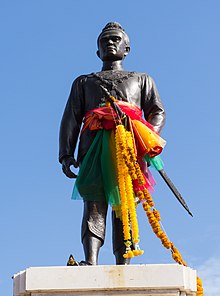Ramathibodi I.


Ramathibodi I. (* 1314 ; † 1369 ), Thai : ( สมเด็จ พระ รามาธิบดี ที่ ๑ ) or U Thong ( พระเจ้า อู่ทอง , Phra Chao U Thong ), was the first king of the Ayutthaya kingdom in Siam (today: Thailand ).
Lineage and Life
Today there are six different legends about the origin of the U Thong . After Prince Damrong Rajanubhab , who worked as an amateur archaeologist, discovered a large ruined city between today's Kanchanaburi and Suphan Buri in 1904 , which the people of the area called Mueang Thao U Thong ("City of King U Thong"), the following version is the most likely.
U Thong was probably born in 1314 as the son of Chodüksethi , an influential Chinese merchant from Phetchaburi and his wife, a daughter of the Prince of Lop Buri . He was married to the daughter of the ruler of the Thai principality ( Müang ) Suphan Buri (historically Suphannaphum ). When the Prince of Suphan Buri died, Prince U Thong was able to take over the throne. However, due to a cholera epidemic that killed many people, the city had to be abandoned. So Prince U Thong went with the rest of his population in search of a new settlement.
He found it at the confluence of three rivers: the Chao Phraya , the Lop Buri and the Pa Sak . Here he founded according to the Chronicles of Ayutthaya
"In the year 712 [ Chula Sakkarat , the" small calendar "], a year of the tiger , the second of the decade, on Friday, the sixth day of the waxing moon in the fifth month , at three nalika and nine bat after daybreak,"
so on March 4, 1351 AD shortly after nine o'clock in the morning, his new capital, which he named "Krung Thep Dvaravati Sri Ayutthaya". The capital Ayodhya of Prince Rama in the Indian epic Ramayana / Ramakian may have been the godfather. From this time on he called himself “Ramathibodi” (composed of Rama and adhipati , Sanskrit for “lord” or “king”).
As the new king, he was able to fill important posts in the surrounding cities with relatives whom he trusted. So he let his brother-in-law Pha Ngua rule in Suphan Buri, the original power center of his family, and put his eldest son Ramesuan on the throne of Lop Buri. Ayutthaya itself was about the same distance from both cities and easily accessible by water. Due to its location, it soon developed into an important port city for long-distance trade. Ramathibodi used this as well as his political and family connections with key people in the neighboring principalities and was able to lead his young kingdom to supremacy in the region in a short time. He combined the labor of the Thai, who lived in large numbers west of the capital, the statecraft of the Khmer (Lop Buri / Lavo had been one of the most important provincial centers of the Khmer Empire of Angkor until the 13th century ) and the merchant spirit of the Chinese traders, from whom he himself may have descended and who settled in the port and trading city of Ayutthaya.
The northern kingdom of Sukhothai had lost massive influence after its peak under Ramkhamhaeng at the end of the 13th century. Ramathibodi concluded an agreement with the local king Mahathammaracha I (Li Thai), so that no attack threatened him from this direction (and vice versa). A more important rival was the Khmer empire, which borders on the east. The king of Ayutthaya was successful in the war with them, possibly even taking Angkor at times. In any case, he was able to "conquer" a larger number of people and relocate them to his domain (in sparsely populated Southeast Asia, the conquest of labor was more important than that of territory).
After Ramathibodi's death in 1369, a controversy about the succession to the throne broke out: First his eldest son Ramesuan came from Lop Buri to ascend the throne. After only one year, however, Ramathibodi's brother-in-law Pha Ngua from Suphan Buri forced him to abdicate and became Borommaracha I as the new king.
Ramathibodi bequeathed two major achievements to his successors
- Introduction of Theravada Buddhism in Ayutthaya
- Laying down of a legal code based on Hindu ideas, adapted to Thai reality. Some of these legal norms are still valid today.
literature
- David K. Wyatt: Thailand. A short history . 2nd edition, Silkworm Books, Chiang Mai 2004, ISBN 978-974-9575-44-4 .
- Richard D. Cushman (transl.): The Royal Chronicles Of Ayutthaya . Bangkok: The Siam Society , 2000, ISBN 974-8298-48-5 .
- Miscellaneous Articles written for the Journal of Siam Society by His Late Royal Highness Prince Damrong . Bangkok: The Siam Society, 1962 (without ISBN).
Individual evidence
- ^ Richard D. Cushman (translator): The Royal Chronicles of Ayutthaya. Siam Society, Bangkok 2000, p. 10. Quoted from David K. Wyatt : Thailand. A short history. 2nd edition, Silkworm Books, Chiang Mai 2004, p. 54.
- ^ Wyatt: Thailand. 2004, p. 54.
- ↑ Christian Velder: Notes on the saga of Rama in Thailand. In: Journal of the Siam Society , Vol. 56, No. 1, 1968, pp. 33-46, at p. 44.
- ^ AB Griswold , Prasert Na Nagara: On Kingship and Society at Sukhodaya. In G. William Skinner, A. Thomas Kirsch: Change and Persistence in Thai Society. Cornell University Press, Ithaca NY 1975, pp. 29-92, at p. 89.
- ^ Wyatt: Thailand. 2004, pp. 54-55.
- ^ Wyatt: Thailand. 2004, p. 57.
- ^ Wyatt: Thailand. 2004, p. 56.
| personal data | |
|---|---|
| SURNAME | Ramathibodi I. |
| ALTERNATIVE NAMES | U thong |
| BRIEF DESCRIPTION | first king of the Kingdom of Ayutthaya in Siam |
| DATE OF BIRTH | 1314 |
| PLACE OF BIRTH | unsure: Suphanburi |
| DATE OF DEATH | 1369 |
| Place of death | Ayutthaya |